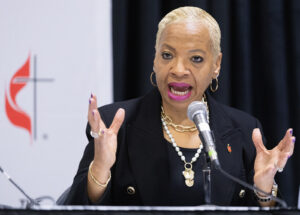
 Church names in the SBC are an interesting study. More than one hundred cooperating churches carry the name Beulah (104). Grace is in the name of 649 congregations. Another 532 are called Immanuel or Emmanuel, and 306 are named Friendship. However, water names seem to dominate with Southern Baptist churches. For example, 1,139 churches have the word Creek in their name. Another 549 contain the word River. We have 850 churches that contain the word Springs in their church name – descriptive names such as Dripping Springs (1), Bath Springs (1), Boiling Springs (8), Clear Springs (11), Cold Springs (7), Cool Springs (10), and so many more.
Church names in the SBC are an interesting study. More than one hundred cooperating churches carry the name Beulah (104). Grace is in the name of 649 congregations. Another 532 are called Immanuel or Emmanuel, and 306 are named Friendship. However, water names seem to dominate with Southern Baptist churches. For example, 1,139 churches have the word Creek in their name. Another 549 contain the word River. We have 850 churches that contain the word Springs in their church name – descriptive names such as Dripping Springs (1), Bath Springs (1), Boiling Springs (8), Clear Springs (11), Cold Springs (7), Cool Springs (10), and so many more.
The early settlers of our nation settled where there was water. So did the biblical patriarchs. When Jesus addressed the woman at the historic site of Jacob's well, He promised her that the water He gives will be a fountain of water springing up to everlasting life (John 4:14 NKJV).
The image of the springs is an apt image to describe the Cooperative Program of the Southern Baptist Convention.
• Springs of water bubble up from deep under the surface of the surrounding terrain.
• Springs of water provide a steady supply of water in times of abundance and in times of drought.
• While springs of water are usually sufficient for one's needs, they are seldom sufficient for all of one's wants.
• And, though springs of water may not supply all of the water we may want at any given time, they are, nevertheless, a dependable source of water year in and year out.
In what way is the Cooperative Program like a spring?
The Cooperative Program bubbles up from the overflow of committed Southern Baptist individuals and churches to fund the cooperative ministries of our Convention. Scripture teaches two kinds of giving – giving one's all and proportional giving. In fact, the Old Testament words for tithe (asar and maasar) and the New Testament word for tithe (dekate) mean one-tenth, or 10 percent. Percentage, or proportional, giving is the basis for the common phrase, "not equal gifts, but equal sacrifice" (see, for example, 2 Corinthians 8:12-14; 1 Corinthians 16:2; Luke 6:38).
The Cooperative Program illustrates the "power of percentages."
• Faithful tithers give a percentage of their income to the Lord through their local churches.
• Cooperating churches give a percentage of their undesignated receipts through the Cooperative Program to fund the ministries of the Convention.
• The Convention adopts a percentage-based allocation budget. All Cooperative Program funds it receives are distributed according to the percentages approved by the Convention.
Simply put, these funds bubble up from voluntary contributions prompted by the Holy Spirit in the hearts of obedient believers as they give through churches committed to our cooperative ministries. These funds are then disbursed in accordance with budgets adopted by godly messengers to the annual meetings of the state conventions and the Southern Baptist Convention.
During the past eighty-four years, though the Cooperative Program has had its ebbs and flows, it has provided a stable base upon which the ministries of the Convention have continued to thrive and grow. The Cooperative Program was severely tested in its infancy with the Great Depression when stock markets crashed worldwide. Nevertheless, even then it provided a steady stream of resources to underwrite our Convention's ministries and missions.
The Cooperative Program continued to provide steady funding for Convention ministries during the historical recessions of the post-WWII era, the post-Korean war era, the 1973 oil crisis, and the "double dip" recession of the early 1980s. Even through the most recent economic challenges of the collapse of the dot-com bubble at the turn of the millennium and the banking collapses of this past year, faithful Southern Baptists have given faithfully of their tithes and offerings to help support the ministries of the their local churches and, through Cooperative Program gifts from those churches, to provide a steady stream of support for the IMB, NAMB, the seminaries, the ERLC, as well as a host of ministries conducted through our cooperating state conventions.
The ministries and entities of our Convention are led by individuals of broad vision. Many of them can dream up more ministries during a daily quiet time than our churches can fund in a lifetime! Though the Cooperative Program by itself will never be sufficient to provide everything we might want, it provides a dependable base of support for our ministry needs. Even in the difficult economic times of this past year, the Cooperative Program has remained strong.
As we have seen recently, designated offerings are financially volatile, rising and falling in dramatic fashion, often serving as a bellwether of the prevailing economic health of the nation. Just like we can all remember the eight-inch rain, we can remember the $150 million offering. On the other hand, just as we remember the summer with no rain, we can easily recall the offering that fell $29 million short of its goal!
Quietly, unassumingly, the springs of the Cooperative Program just continue to gurgle in the background, almost unheeded until economic times are tight. These springs produce steadily, day in, day out, year in, year out. Over a lifetime, the volume of water that these springs generate is phenomenal.
The springs of the Cooperative Program enable Southern Baptists to water the seeds of the Gospel planted by a host of missionaries, seminarians, disaster relief volunteers, and other godly laymen and women who render their daily service to the Lord. We scatter these seeds in anticipation of an abundant harvest of souls. Put another way, the Cooperative Program enables our Convention ministry leaders to plan their ministries in anticipation of a predictable, dependable revenue stream from the springs of the Cooperative Program.
Faithful tithers continue to tithe – because it is a reflection of who they are in Christ. Faithful churches continue to give – because supporting the ministries and missions of the Southern Baptist Convention is in keeping with their intentional missions strategies they as local churches have adopted. And, through these faithful gifts, our cooperative ministries continue to fulfill the vision of global missions, North American evangelism and church planting, theological education, and cultural engagement-none ever having all the funds they would like, but each having enough to accomplish His purposes through us.















